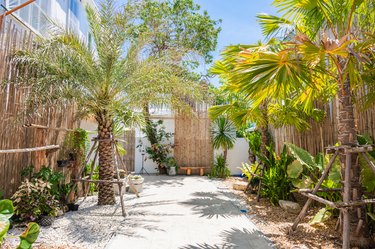
Scale are insects that suck the sap from the foliage of host plants. Numerous species of scale insects exist, and when a specific species attacks a host that is vulnerable to it, this can quickly kill the plant. A scale infestation affects all parts of a plant, but in palm trees, damage is most prevalent on the leaves, also called fronds.
How to Identify the Type of Scale on a Plant
It's vital to identify the species of scale infesting a plant because insecticides balanced to eradicate one species of scale may be entirely ineffective on another. Here are a few common types of scale:
- Armored scales live under a platelike, nippled cover that is approximately 1/8 inch in diameter.
- Soft scales reach a maximum length of approximately 1/4 inch and have a smooth, waxy surface.
- Although less frequently encountered, European elm scale, cottony cushion scale, sycamore scale, and oak pit scale can all cause problems.
Video of the Day
Killing Scale on Palm Tree Leaves
1. Prevent Scale Infestations Through Cultural Care
Discourage scale infestation by providing appropriate irrigation and pruning. Palms maintained in over-wet conditions and in soils with poor drainage are more susceptible to dangerous or unattractive scale. Scale is naturally kept in check by high levels of uninterrupted sun exposure, so pruning can help. Prune off any limbs or fronds that are excessively dense. Open up the canopy by rigorously cutting back upper foliage.
Video of the Day
2. Take Advantage of Scale's Natural Enemies
Monitor your plants' environment to allow natural enemies to eradicate the parasites. The larvae of small parasitic wasps are voracious scale predators, as are many beetles, lady beetles, bugs, lacewings, and mites. Eggs and larvae of beneficial species that do well in specific locales may be available from landscaping suppliers.
3. Prevent Ant Infestations
Prevent ants from occupying the area around a plant. Scale can flourish when their natural enemies are prevented from working by ants tending what are effectively farmed herds of scale insects. Wrap the palm's trunk with a collar of fabric tree wrap and fit wedges into uneven areas; then coat the collar with a sticky substance to stop ants from climbing up the tree.
4. Treat With Horticultural Oil or Soap
Spray the infested plant with narrow-range horticultural oil, insecticidal soap, or a mixture of oil and soap, in the palm's least active season, usually late winter. The plant must be completely sprayed: trunk, branches, and even the underside of fronds. This measure should be taken only when fog and rain are not expected for at least 24 hours.
5. Try Systemic Insecticides
Apply systemic insecticides, which are absorbed into the tree then transferred to the parasite in lethal doses, where spraying and environmental control are not practical options. Use systemic insecticides according to the manufacturer's instructions; some are applied to the tree's roots where they are absorbed, others are injected or implanted into the trunk.
6. Resort to Contact Insecticides if Necessary
Use contact insecticides as a last resort in scale control. Although they are effective in killing the insects, they also cause great disruption in the life cycles of beneficial insects and mites.